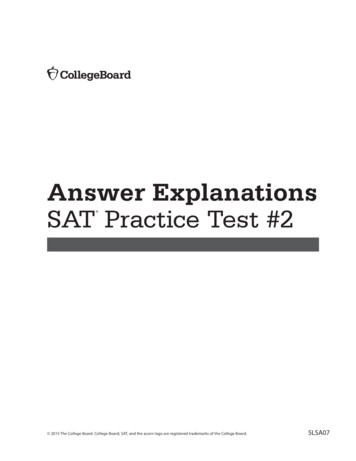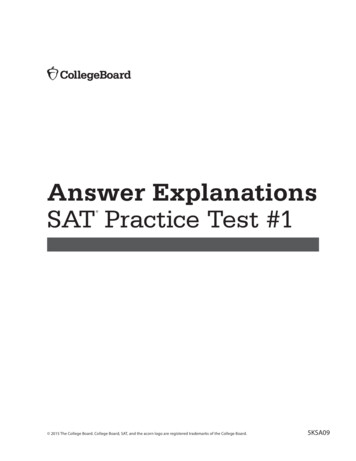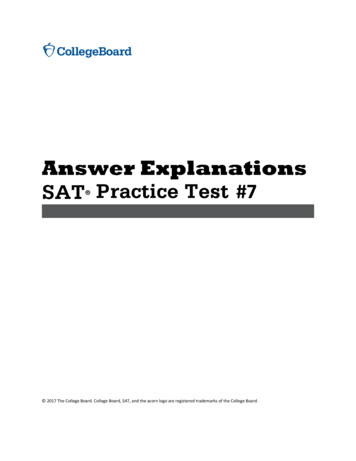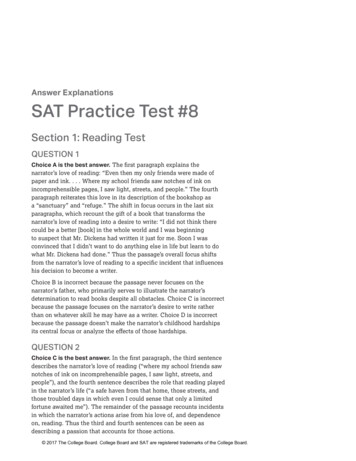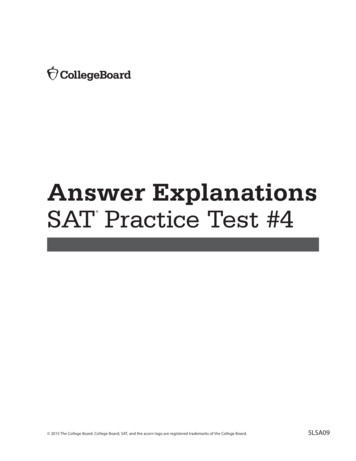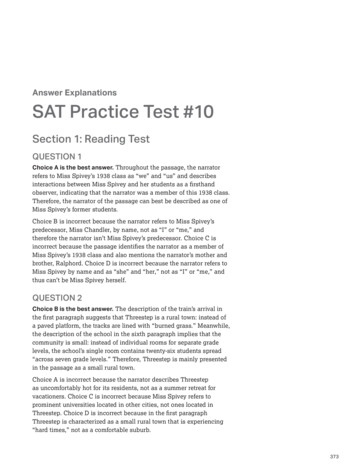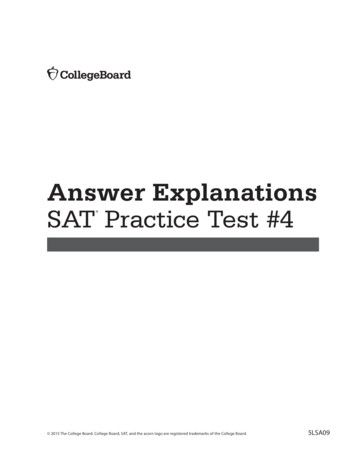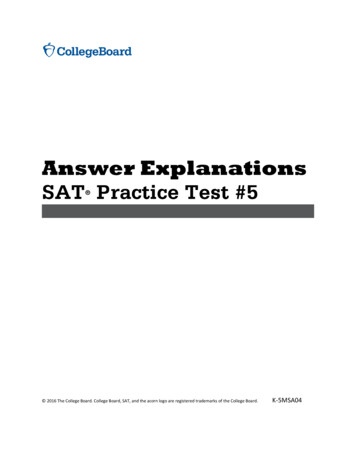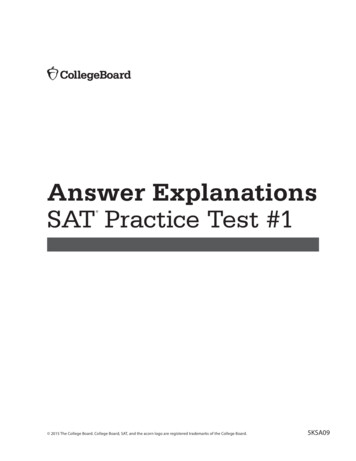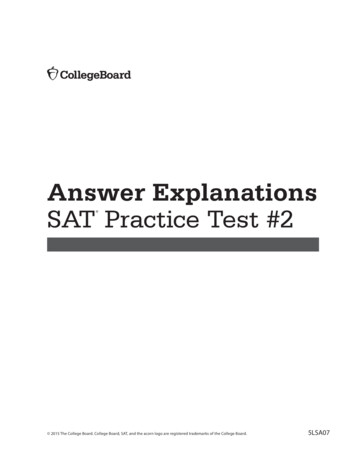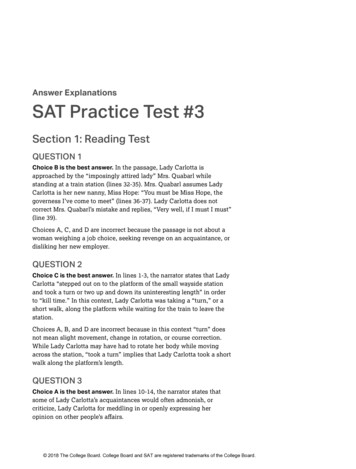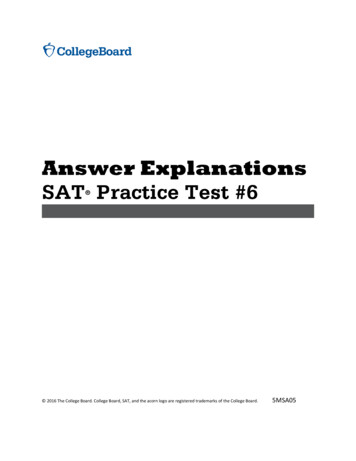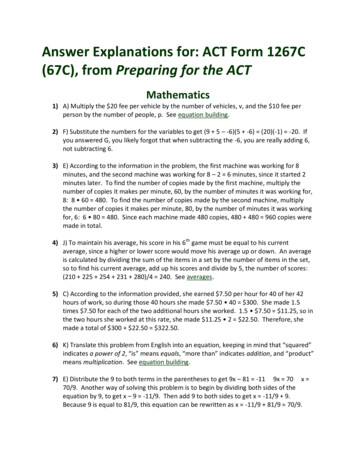
Transcription
Answer Explanations for: ACT Form 1267C(67C), from Preparing for the ACTMathematics1) A) Multiply the 20 fee per vehicle by the number of vehicles, v, and the 10 fee perperson by the number of people, p. See equation building.2) F) Substitute the numbers for the variables to get (9 5 – -6)(5 -6) (20)(-1) -20. Ifyou answered G, you likely forgot that when subtracting the -6, you are really adding 6,not subtracting 6.3) E) According to the information in the problem, the first machine was working for 8minutes, and the second machine was working for 8 – 2 6 minutes, since it started 2minutes later. To find the number of copies made by the first machine, multiply thenumber of copies it makes per minute, 60, by the number of minutes it was working for,8: 8 60 480. To find the number of copies made by the second machine, multiplythe number of copies it makes per minute, 80, by the number of minutes it was workingfor, 6: 6 80 480. Since each machine made 480 copies, 480 480 960 copies weremade in total.4) J) To maintain his average, his score in his 6th game must be equal to his currentaverage, since a higher or lower score would move his average up or down. An averageis calculated by dividing the sum of the items in a set by the number of items in the set,so to find his current average, add up his scores and divide by 5, the number of scores:(210 225 254 231 280)/4 240. See averages.5) C) According to the information provided, she earned 7.50 per hour for 40 of her 42hours of work, so during those 40 hours she made 7.50 40 300. She made 1.5times 7.50 for each of the two additional hours she worked. 1.5 7.50 11.25, so inthe two hours she worked at this rate, she made 11.25 2 22.50. Therefore, shemade a total of 300 22.50 322.50.6) K) Translate this problem from English into an equation, keeping in mind that “squared”indicates a power of 2, “is” means equals, “more than” indicates addition, and “product”means multiplication. See equation building.7) E) Distribute the 9 to both terms in the parentheses to get 9x – 81 -11 9x 70 x 70/9. Another way of solving this problem is to begin by dividing both sides of theequation by 9, to get x – 9 -11/9. Then add 9 to both sides to get x -11/9 9.Because 9 is equal to 81/9, this equation can be rewritten as x -11/9 81/9 70/9.
8) H) If he bought 60 worth of 4 tickets, then he bought a total of 60/ 4 15 tickets.Add his total savings to the amount he spent to find the regular price of these 15 tickets: 60 37.50 97.50. Now determine the regular price per ticket by dividing theregular price of 15 tickets, 97.50 by 15: 97.50 / 15 6.50 per ticket.9) A) You could expand this expression using the FOIL method, by multiplying the two Firstterms, the two Outer terms, the two Inner terms, and the two Last terms. However, thebetter way of solving is to recognize that this is an instance of the difference of twosquares. The difference of two square states that (x a)(x – a) x2 – a2. Since theexpression is of the form of the left side of this identity, it can be expanded to the formof the right side of this identity: (3x)2 – (4y2)2 9x2 – 16y4. Remember that the power of2 must be distributed to both of the two terms that are multiplied together (thecoefficient and the variable) inside the parentheses. If you did not know how to solvethis problem, you could have gotten the correct answer by plugging in your ownnumbers for x and y, solving the equation in the question for a numeric value, and thenplugging the same numbers into the answer choices for x and y to see which one orones yield the same value. If more than one answer choice works initially, repeat usingdifferent numbers. See exponents and radicals and quadratics.10) J) The area of a rectangle is equal to length times width, so lw 32. The perimeter of arectangle is equal to twice the sum of the length and the width, so 2(l w) 24 l w 12. At this point, you could use the two equations to solve via substitution, but thiswould be unnecessarily time consuming, since you would be left with a quadratic afterperforming the substitution. A better idea is to simply find two numbers that add to 12and multiply to 32: 4 and 8. Therefore, the longer side is 8 feet in length and the shorterside is 4 feet in length. See equation building and plane geometry.11) D) The sum of the three angles in a triangle is equal to 180 , so if the sum of two anglesis 47 , then the third angle must be equal to 180 – 47 133 . See plane geometry.12) K) Four events are occurring (a sandwich, a soup, a salad, and a drink are each chosen).Therefore, you should draw out four “slots” with multiplication signs in between them: . Then populate each slot with how many ways each event can occur: 3 3 4 2 72 different possible meals. See counting and probability.13) B) Begin by translating the English into a mathematical equation. Let the smaller integerbe x. The larger integer could then be written as (x 1), since consecutive integers arealways 1 apart. “Triple” means 3 times and “is” means equals, so you can set up thefollowing equation: x 3(x 1) 79 x 3x 3 79 4x 76 x 19. Since wedesignated x as the smaller number when setting up the equation, the answer is B. Ifyou chose A, you may have done everything right but forgotten that x was the smaller,not the larger number. Likewise, if you chose C, you may have initially designated x asthe larger number when setting up your equation, but then mistakenly confused it forthe smaller number after solving the equation. See equation building.
14) F) To evaluate an equation written in function notation (f(x)), substitute whatever is inthe parentheses for x in the equation. Since -3 is in the parentheses, this gives you -8(3)2 -8(9) -72. If you answered G, you likely made the mistake of thinking that (-3)2 9, when in reality (-3)2 9. This mistake was possibly the result of a calculator error,since you must put -3 in parentheses before squaring it to obtain the correct result. Ifyou answered J or K, you might have mistakenly squared the -8 in addition to the -3.See function notation and exponents and radicals.15) C) This problem could be solved using logarithms. Take log 3 of both sides to get log33x log354. Since log3 cancels the base of 3, you are left with x log 354. Evaluate the rightside of this equation on your calculator using the change of base property: x log54/log3 3.63, so B is the correct answer. Another way of solving this problem issimply by guess and check. The answers involve ranges into which the actual value of xwill fall rather than specific values of x in order to prevent students from using guessand check, but it is possible to do so anyways. Begin by calculating 33, since 3 is in themiddle of the numbers offered in the answer choices. Since 33 27, which is less than54, x must be greater than 3. Next calculate 34. 34 81, which is greater than 54, so xmust be less than 4. Therefore, you know that x must be between 3 and 4.16) J) The quickest way to find a least common multiple on the ACT is to guess and check.Always start with the lowest answer choice offered and work your way up. That way,the first answer choice you try that is in fact a multiple of all three numbers must be theleast common multiple. Using your calculator or in your head, check to see if theanswer choice yields an integer when divided by 70, 60, and 50. F is eliminated becauseneither 70 nor 50 goes evenly into 60. G is eliminated because neither 70 nor 50 goesevenly into 180. H is eliminated because neither 60 nor 50 goes evenly into 210. J is thecorrect answer because 70, 60, and 50 all go evenly into 2100, since 2100/70 30,2100/60 35, and 2100/50 42. Although 21,000 is also a common multiple of thesethree numbers, K is incorrect because it is not the least common multiple.17) B) The volume of a rectangular prism can be found according to the following formula: v lwh, where l, w, and h, are the length, width, and height, respectively. Since you knowthe length, width, and volume of the rectangular prism in the question, you can plugthese values into the equation to solve for h, the height. (45)(30)h 81,000 1350h 81000 h 81,000/1350 60.18) J) This problem is much easier if you draw it. Paying close attention to the details fromthe problem, you get the following drawing. Note that the numbers labeled representthe arc lengths between consecutive labeled points:
This drawing reveals that J is the correct answer. If you answered G, you may have doneeverything correctly but put the points in order going counter-clockwise around thecircle. This problem also could have been done without drawing a circle just byconsidering A both point 0 and point 15, since the circumference is 15. To find eachpoint’s “coordinate” (with lower numbers being closer to A in the clockwise direction),add to 0 the units the point is clockwise from A, or subtract from 15 the units the pointis counterclockwise from A. Hence, B 15 – 2 13, C 0 5 5, and D 0 7 (or 15 –8) 7. The order these points moving clockwise from A is then the same as theincreasing order of their “coordinate.” See circles.19) D) Simply plug in 5 for t and solve for y: y 16(2)5 16(32) 512. See exponents andradicals.20) J) The area of a rectangle is equal to its length multiplied by its width. Call the lengthand width of the smaller rectangle l and w, respectively. Therefore, the area of thesmaller rectangle is equal to lw. If the larger rectangle has the same width and a length3 times that of the smaller one, then its area is equal to 3lw, which is 3 times lw, thearea of the smaller rectangle. Therefore, k 3. If you answered G, you may have doneeverything correctly but mistakenly thought kA was the area of the smaller rectangleand A the area of the larger rectangle. If you answered K, you may have mistakenlythought that the length and the width of the larger rectangle were both 3 times largerthan the length and width of the smaller rectangle. See plane geometry.21) E) Combine like terms, making sure that you properly distribute the negative to eachterm in the second parentheses. a – 4a -3a, 2b – 6b -4b, and 3c – -5c 3c 5c 8c,so E is the correct answer. If you answered D, you forgot to distribute the negative tothe last term and subtracted 5c instead of adding 5c.22) G) Sin opposite/hypotenuse, so sin a/c. Note that the opposite side is always theleg directly across from the angle, while the hypotenuse is always the longest side of aright triangle. See basic trigonometry.23) B) According to these rules, the player who begins with the ball will end up getting theball back on the 5th pass, after each of the other players has touched the ball exactlyonce. It is useful to conceptualize this problem visually by drawing it out. Begin bydrawing the 5 players (depicted as points arranged roughly in a circle). If you connect
these points according to the rules in the question, it will create a 5 pointed star, andthe player who began with the ball will get the ball back on the 5th pass.24) H) The slope of a line is equal to m in y mx b (slope intercept) form. Hence, the slopeof p is 0.12, and the slope of n is 0.12 .1 0.22. See coordinate geometry.25) A) Distribute the -8x3 to each of the two terms inside the parentheses. Remember todistribute the negative, and also remember that when you multiply the bases, you addthe exponents. -8x3(7x6) -56x9 and -8x3(-3x5) 24x8, so A is the correct answer. If youanswered B, you forgot to distribute the negative to the second term. If you answered Cor D, you multiplied the exponents instead of adding them. If you answered E, you triedto combine all the terms into a single term, which cannot be done. See exponents andradicals.26) G) Add the terms within the absolute value bars to get 2. Since the absolute value of 2is equal to 2, multiply 2 by -3 to get the answer to this problem: -6. If you answered J,you may have made your answer positive at the end due to the presence of theabsolute value. Although an absolute value itself cannot be negative, the result of theabsolute value is multiplied by -3 in this question, which does indeed yield a negativenumber. If you answered F, you probably made the -6 into a positive 6 before adding itto the 8. Remember that an absolute value does not require you to make all the termsinside of it positive; instead, you must perform the mathematical operations within theabsolute value and only after doing so make the result positive if it is negative. Seeabsolute values.27) B) Since triangles ACE and BCD have the same angle measurements, they are similar.The corresponding parts of similar figures are in proportion, so you can solve thisproblem by setting up a proportion. Before doing so, however, you must find thehypotenuse of triangle BCD, line segment BC. Although you could use the PythagoreanTheorem to find this hypotenuse (32 42 x2), you can avoid doing so if you recognizethat you have a 3-4-5 Pythagorean Triple. Either way, you get that BC 5. Now you areready to set up your proportion. When doing so, make sure your units line up on bothsides. In other words, this/that this/that. In this case, (short leg)/(hypotenuse) (short leg)/(hypotenuse), so 3/5 x/20. Multiply both sides by 20 to get x 12. Even ifyou did not know how to do this problem, you may have been able to get the correctanswer just by estimating the length of AE visually. AE certainly appears to be greaterthan half the length of AC, so it must be greater than 10, and it appears to be less than3/4 of AC, so it should be less than 15. Remember that despite what is stated in thedirections, all illustrative figures are in fact drawn to scale. See ratios and proportionsand plane geometry.28) H) In a linear equation of the form y mx b, m is the slope and b is the y-interce
Answer Explanations for: ACT Form 1267C (67C), from Preparing for the ACT Mathematics 1) A) Multiply the 20 fee per vehicle by the number of vehicles, v, and the 10 fee per person by the number of people, p. See equation building. 2) F) Substitute the numbers for the variables to get (9 5 – -6)(5
